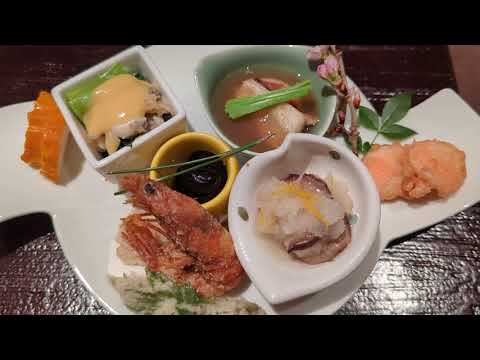This was the first of two dinners that we had served in our room while staying at Kakunodate Sanso Wabizakura ryokan (角館山荘 侘桜), a luxury boutique Onsen (natural thermal hot springs) ryokan (inn) with just 10 rooms total. All meals were served in our own room (which has a private dining room.) This definitely ranks among the finest ryokan meals we’ve ever had. The menu as well as explanation of each serving was in Japanese, but I’ve tried my best to summarize it here, in both languages. They are:
COURSE 1 – Zatsuki (座附 – Appetizer):
* Gomadofu Genmai Age Oroshi (胡麻豆腐玄米揚げ卸し – Fried Sesame Tofu with Brown Rice and with grated Daikon Radish)
– Awafu (粟麩 – Millet Gluten)
– Goshiki Kasumi (五色霞)
– Aonegi (青葱 – Green Onions)
– Hari Yuzu Ponzu (針柚子ポン酢 – Yuzu Citrus Ponzu Sauce)
COURSE 2 – Zensai (前菜 – Appetizer #2):
* Yurine Bainiku-age (百合根梅肉揚げ – Lily Bulb fried with the Pulp of Pickled Umeboshi Plums (the seeds are removed and mashed))
* Komochi Yari Ika-ni (子持ち槍烏賊煮 – Simmered pregnant Spear Squid filled with its own eggs)
* Aka Namako Yuzu Oroshi (赤海鼠柚子卸し – Japanese Spiky Sea Cucumber and Grated Daikon Radish with Yuzu Citrus)
* Budo-mame (葡萄豆 – Kuromame Sweet Black Soybeans)
* Dappi Ebi Karaage (脱皮海老唐揚げ – Fried Freshly Molted Shrimp, so the shell can be eaten as well)
* Taranome Tempura (タラの芽天ぷら – Japanese Angelica Tree Sprouts Tempura)
* Shirakami San Udo Hakusen-age (白神山独活白扇揚げ – Japanese Spikenard/Aralia Cordata fried with a batter of potato starch)
* Muki Asarigai Kujo Negi Wakame Karashi Sumiso-kake (剥き浅利貝九条葱若芽辛子酢味噌掛け – Japanese Littleneck Clam with Long Green Onions from Kyoto and Wakame Seaweed, flavored with Fermented Miso Soybean Paste and Vinegared Japanese Mustard sauce)
* Ika no Uniyaki (烏賊の雲丹焼き – Squid cooked with Kneaded Sea Urchin and Grain Sea Urchin that’s been spread with Egg Yolk)
COURSE 3 – Otsukuri (御造り – Sashimi):
* Hirame Usuzukuri (平目薄造り – Thinly Sliced Flounder/Sole/Flat Fish)
– Momiji Oroshi (紅葉卸し – Grated Daikon Radish with Togarashi Chili Peppers)
– Aonegi (青葱 – Green Onions)
– Ponzu (ポン酢 – Ponzu Citrus Sauce)
COURSE 4 – Yakimono (焼物 – Grilled Dish):
* Kamasu no Ichiyaboshi (魳の一夜干し – Barracuda dried overnight)
– Some Oroshi (染め卸し – Grated Daikon Radish with Soy Sauce and Lemon)
– Sudachi (酢橘 – Sudachi Citrus)
* Hinai Jidori Moromi Hachimitsu-yaki (比内地鶏醪漬け蜂蜜焼き – Hinai Chicken from Odate in Akita, grilled with Honey and Moromi (the mash from which Fermented Soybean paste is made))
* Yama Udo Sansho Amazu-zuke (山独活山椒甘酢漬け – Wild Aralia Cordata flavored with Sansho Japanese Peppers and Sweet and Sour Vinegar)
* Shiitake Konbu (椎茸昆布 – Shiitake Mushrooms with Konbu Sea Kelp)
COURSE 5 – Shiizakana (強肴 – Large, Hot Dish):
* Madai Kabuto Sakamushi (真鯛兜酒蒸し – Sake-steamed Japanese Sea Bream head)
– Tofu (豆腐)
– Naganegi (長葱 – Naga Negi, aka. Tokyo Negi & Shiro Negi – Long Japanese Green Onion)
– Shimeji (占地 – Shimeji Mushrooms)
– Enoki (榎茸 – Enoki Mushrooms)
– Shiitake (椎茸 – Shiitake Mushrooms)
COURSE 6 – Oshokuji (御食事 – Rice Dish):
* Mushikago Gohan (蒸籠御飯 – Rice steamed in a basket)
– Zuwai-gani (図合蟹 – Zuwai-gani Red Snow Crab)
– Shirasu (しらす – Whitebait)
– Jiku Mitsuba (軸三つ葉 – Japanese Wild Parsley)
* Tomewan (留め椀 – Soup Dish):
– Akadashi (赤出汁 – Fermented Red Miso Soybean Paste Soup)
* Kounomono (香の物 – Pickled vegetables)
– Iburi Daikon (いぶり大根 – Smoked & Pickled Daikon Radish)
– Daikon (大根 – Daikon Radish)
– Daikon Nappa (大根の葉っぱ – Daikon Radish Leaves)
– Kyuri (胡瓜 – Cucumber)
– Ninjin (人参 – Carrots)
COURSE 7 – Mizugashi (水菓子 – Fruit-based Dessert):
* Ichigo Sorbet (苺ソルベ – Strawberry Sorbet)
* Kisetsu no Kudamono (季節の果物 – Seasonal Fruits)
– Orange (オレンジ)
– Suika (西瓜 – Watermelon)
– Ichigo (苺 – Strawberries)
– Shine Muscat (シャインマスカット – Shine Muscat Grape)


AloJapan.com